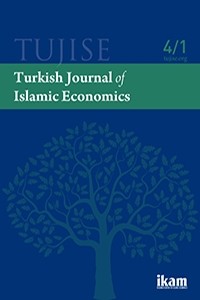GREEN SUKUK FOR FINANCING RENEWABLE PROJECT
GREEN SUKUK FOR FINANCING RENEWABLE PROJECT
This paper investigates the application of the Green Sukuk, particularly, for financing the renewable energy. More precisely, three case studies had been chosen for discussion. In the first case study, we highlights “Hybrid Sukuk” framework adopted by Tadau Energy Sdn. Bhd. for financing solar photovoltaic (PV) plants. The second case study, we reviewed on “Sukuk Wakalah” issued by BEWG (M) Sdn. Bhd., as an ideal solution for water treatment project. Finally, for the third case study, we have discussed in details about “Sukuk Murabahah” which being used by Sarawak Hydro Sdn. Bhd. for financing the hydroelectric plant (BAKUN hydroelectric project).
___
- References
- Afshar, T. A. (2013). Compare and Contrast Sukuk (Islamic Bonds) with Conventional Bonds, Are they Compatible? . Journal of Global Business Management, 9 (1), 44-52.Ahmad, S., Ab Kadir, M. Z., & Shafie, S. (2011). Current Perspective of the Renewable Energy Development in Malaysia. Renewable and Sustainable Energy Reviews, 15 (2), 897-904.Alam, N., Duygun, M., & Ariss, R. T. (2016). Green Sukuk: An Innovation in Islamic Capital Markets. In A. Dorsman, Ö. Arslan-Ayaydin, & M. B. (eds), Energy and Finance: Sustainability in the Energy Industry (pp. 167-185). Springer.Bo, D., Ali, E. R., & Ali, B. (2016). Sukuk Issuance in China: Trends and Positive Expectations. International Review of Management and Marketing, 6 (4), 1020-1025.Godlewski, C., Ariss, R. T., & Weill, L. (2013). Sukuk vs. Conventional bonds: A Stock Market Perspective. Journal of Comparative Economics, 41 (3), 745-761.Malaysia International Islamic Financial Centre. (2016). SRI & Green Sukuk: Challenges & Prospects. Kuala Lumpur: Bank Negara Malaysia.Mujahid, S. M., & Ali, E. R. (2016). Potential Role of Social Impact Bond and Socially Responsible Investment Sukuk as Financial Tools that Can Help Address Issues of Poverty and Socio-Economic Insecurity . Intellectual Discource, Special Issue, 343-364.Mustapa, S. I., Peng, L. Y., & Hashim, A. H. (2010). Issues and Challenges of Renewable Energy Development: A Malaysian Experience. roceedings of the International Conference on Energy and Sustainable Development: Issues and Strategies. Chiang Mai, Thailand.Sain, M. R., Rahman, M. M., & Khanam, R. (2016). Financial Exclusion in Australia: Can Islamic Finance Minimise the Problem? . Australasian Accounting Business and Finance Journal,10 (3), 89-104.Securities Commission Malaysia. (2017, November 1). Malaysia’s First Green Sukuk under SC’s Sustainable Responsible Investment Sukuk Framework . Retrieved from https://www.sc.com.my/post_archive/malaysias-first-green-sukuk-under-scs-sustainable-responsible-investment-sukuk-framework/Shahzad, F., Zia, A., Fareed, Z., & Zulfiqar, B. (2014). Growth of Islamic Banking in Middle East and South Asian Countries. International Journal of Management, Accounting and Economics, 1 (3), 215-228.Sovacol, B. K., & Bulan, L. C. (2011). Behind an Ambitious Mega Project in Asia: The History and Implications of the Bakun Hydroelectric and Dam in Borneo. Energy Policy, 39, 4842-4859.The Star Online. (2017, August 16). Sarawak Energy Takes Control of Bakun Hydroeletric Plant. Retrieved from https://www.thestar.com.my/business/business-news/2017/08/16/sarawak-energy-takes-control-of-bakun-hydroelectric-plantWorld Finance. (2017, October 26). World Finance Islamic Finance Awards 2018. Retrieved from https://www.worldfinance.com/islamic-finance-awards
- Başlangıç: 2014
- Yayıncı: Research Center for Islamic Economics (ikam)
